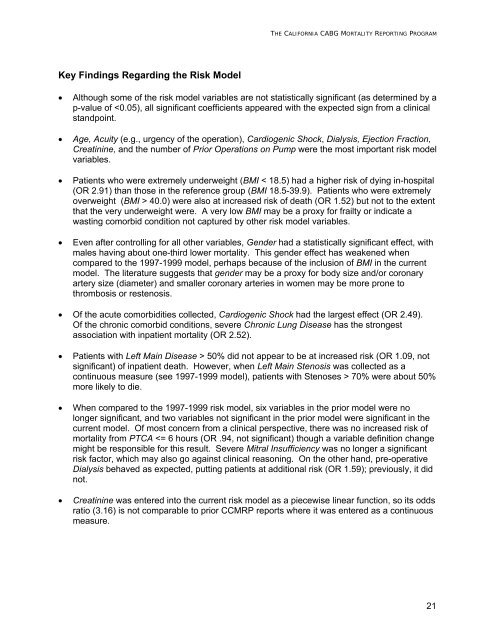THE CALIFORNIA CABG MORTALITY REPORTING PROGRAMCalibrati<strong>on</strong>Calibrati<strong>on</strong> refers to the ability of a model to match predicted and observed death rates acrossthe entire spread of the data. A model in which the number of observed deaths aligns well withthe number of deaths predicted by the model dem<strong>on</strong>strates good calibrati<strong>on</strong>. Good calibrati<strong>on</strong>is essential for reliable risk adjustment. A comm<strong>on</strong> measure of calibrati<strong>on</strong> is the Hosmer andLemeshow χ 2 -statistic, which compares observed and predicted outcomes over deciles of risk.<str<strong>on</strong>g>The</str<strong>on</strong>g> Hosmer-Lemeshow test statistic is 29.1 (df=8; p-value=0.00) for the 2000-2002 model (i.e.,reject the null hypothesis that there is no difference between actual and predicted deaths). Thisresult was not a major cause for c<strong>on</strong>cern; with such a large sample it is comm<strong>on</strong> to fail theHosmer-Lemeshow test.<str<strong>on</strong>g>The</str<strong>on</strong>g> next step was to inspect the difference between the actual number of deaths and thepredicted number of deaths (derived from the risk model) in each of 10 risk groups. <str<strong>on</strong>g>The</str<strong>on</strong>g> 10groups are created by sorting all observati<strong>on</strong>s by the predicted risk of death and then dividingthe sorted observati<strong>on</strong>s into deciles of approximately equal size. Table 4 shows the calibrati<strong>on</strong>of the 2000-2002 risk-adjustment model.Table 4: Calibrati<strong>on</strong> of 2000-2002 Model (n=57,388)GroupNMinimumPredictedRiskMaximumPredictedRiskActualDeathsExpectedDeathsDifference1 5,740 0.001 0.004 3 15.2 (12.2)2 5,739 0.004 0.005 24 26.1 (2.1)3 5,739 0.005 0.007 35 36.7 (1.7)4 5,739 0.007 0.010 31 48.8 (17.8)5 5,741 0.010 0.013 46 63.5 (17.5)6 5,739 0.013 0.016 77 82.6 (5.6)7 5,740 0.016 0.022 126 110.3 15.78 5,740 0.022 0.033 167 155.4 11.69 5,739 0.033 0.057 277 245.8 31.210 5,732 0.057 0.962 769 770.6 (1.6)<str<strong>on</strong>g>The</str<strong>on</strong>g> first row of Table 4 shows the decile of patients at lowest risk of in-hospital death in theCCMRP model (e.g., the 5,740 patients whose predicted risk of dying ranged from 0.001 to0.004). Am<strong>on</strong>g the first decile, three patients died, but the model predicted death for 15 of thepatients. Assuming a Poiss<strong>on</strong> distributi<strong>on</strong> for a binary outcome with mean 0.0026 (15.2 ÷5,740), the predicted range of deaths for the first decile is eight to 23. <str<strong>on</strong>g>The</str<strong>on</strong>g> observed number ofthree deaths falls below the expected range. However, 49% of actual deaths occurred in the10 th decile, the highest risk decile of patients, where 769 patients died compared to 771 deathspredicted by the model. <str<strong>on</strong>g>The</str<strong>on</strong>g> predicted range for the tenth decile is 716 to 825 deaths. <str<strong>on</strong>g>The</str<strong>on</strong>g>number of observed deaths is very nearly the exact number predicted by the model. Overall, inseven of the ten groups, the number of actual deaths is within the range of expected deaths.Although for groups 1, 4, and 5, the number of observed deaths is below the number ofexpected deaths, the model calibrati<strong>on</strong> shows that the risk model has accurately predicted thenumber of expected deaths, especially for patients with the highest risk of dying.20
THE CALIFORNIA CABG MORTALITY REPORTING PROGRAMKey Findings Regarding the Risk Model• Although some of the risk model variables are not statistically significant (as determined by ap-value of 40.0) were also at increased risk of death (OR 1.52) but not to the extentthat the very underweight were. A very low BMI may be a proxy for frailty or indicate awasting comorbid c<strong>on</strong>diti<strong>on</strong> not captured by other risk model variables.• Even after c<strong>on</strong>trolling for all other variables, Gender had a statistically significant effect, withmales having about <strong>on</strong>e-third lower mortality. This gender effect has weakened whencompared to the 1997-1999 model, perhaps because of the inclusi<strong>on</strong> of BMI in the currentmodel. <str<strong>on</strong>g>The</str<strong>on</strong>g> literature suggests that gender may be a proxy for body size and/or cor<strong>on</strong>aryartery size (diameter) and smaller cor<strong>on</strong>ary arteries in women may be more pr<strong>on</strong>e tothrombosis or restenosis.• Of the acute comorbidities collected, Cardiogenic Shock had the largest effect (OR 2.49).Of the chr<strong>on</strong>ic comorbid c<strong>on</strong>diti<strong>on</strong>s, severe Chr<strong>on</strong>ic Lung Disease has the str<strong>on</strong>gestassociati<strong>on</strong> with inpatient mortality (OR 2.52).• Patients with Left Main Disease > 50% did not appear to be at increased risk (OR 1.09, notsignificant) of inpatient death. However, when Left Main Stenosis was collected as ac<strong>on</strong>tinuous measure (see 1997-1999 model), patients with Stenoses > 70% were about 50%more likely to die.• When compared to the 1997-1999 risk model, six variables in the prior model were nol<strong>on</strong>ger significant, and two variables not significant in the prior model were significant in thecurrent model. Of most c<strong>on</strong>cern from a clinical perspective, there was no increased risk ofmortality from PTCA



